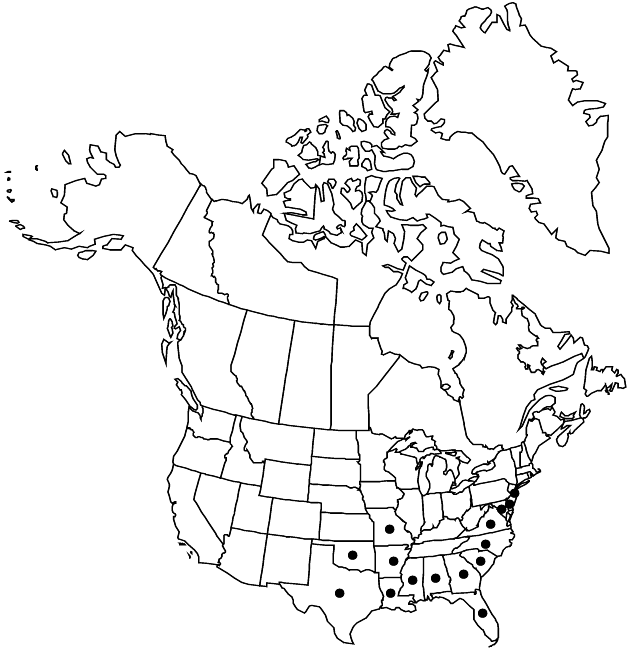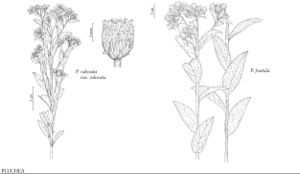Difference between revisions of "Pluchea foetida"
in A. P. de Candolle and A. L. P. P. de Candolle, Prodr. 5: 452. 1836.
FNA>Volume Importer |
FNA>Volume Importer |
||
| Line 8: | Line 8: | ||
}} | }} | ||
|common_names=Stinking camphorweed | |common_names=Stinking camphorweed | ||
| − | |basionyms={{Treatment/ID/ | + | |basionyms={{Treatment/ID/Basionym |
|name=Baccharis foetida | |name=Baccharis foetida | ||
|authority=Linnaeus | |authority=Linnaeus | ||
| + | |publication_title=Sp. Pl. | ||
| + | |publication_place=2: 861. 1753 | ||
}} | }} | ||
|synonyms={{Treatment/ID/Synonym | |synonyms={{Treatment/ID/Synonym | ||
| Line 39: | Line 41: | ||
|elevation=0–20 m | |elevation=0–20 m | ||
|distribution=Ala.;Ark.;Del.;Fla.;Ga.;La.;Md.;Miss.;Mo.;N.J.;N.C.;Okla.;S.C.;Tex.;Va.;Mexico;West Indies (Hispaniola). | |distribution=Ala.;Ark.;Del.;Fla.;Ga.;La.;Md.;Miss.;Mo.;N.J.;N.C.;Okla.;S.C.;Tex.;Va.;Mexico;West Indies (Hispaniola). | ||
| − | |discussion=<p><i>Pluchea foetida</i> <i></i>var.<i> imbricata</i> has not been treated as distinct from typical <i>P. foetida</i> by recent authors (e.g., A. Cronquist 1980; R. K. Godfrey and J. W. Wooten 1981; R. P. Wunderlin et al. 1996). Although plants similar to the type can be found scattered in Florida and Georgia, a populational integrity does not appear to occur, and intermediate forms exist. Nevertheless, field biologists should be aware of the putative distinctions of <i></i>var.<i> imbricata</i> to make more critical observations regarding its status.</p> | + | |discussion=<p><i>Pluchea foetida</i> <i></i></i>var.<i><i> imbricata</i> has not been treated as distinct from typical <i>P. foetida</i> by recent authors (e.g., A. Cronquist 1980; R. K. Godfrey and J. W. Wooten 1981; R. P. Wunderlin et al. 1996). Although plants similar to the type can be found scattered in Florida and Georgia, a populational integrity does not appear to occur, and intermediate forms exist. Nevertheless, field biologists should be aware of the putative distinctions of <i></i></i>var.<i><i> imbricata</i> to make more critical observations regarding its status.</p> |
|tables= | |tables= | ||
|references= | |references= | ||
| Line 77: | Line 79: | ||
|publication year=1836 | |publication year=1836 | ||
|special status= | |special status= | ||
| − | |source xml=https://jpend@bitbucket.org/aafc-mbb/fna-data-curation.git/src/ | + | |source xml=https://jpend@bitbucket.org/aafc-mbb/fna-data-curation.git/src/f6b125a955440c0872999024f038d74684f65921/coarse_grained_fna_xml/V19-20-21/V19_811.xml |
|tribe=Asteraceae tribe Plucheeae | |tribe=Asteraceae tribe Plucheeae | ||
|genus=Pluchea | |genus=Pluchea | ||
Revision as of 18:38, 24 September 2019
Annuals or perennials, 40–100 cm; fibrous-rooted, sometimes rhizomatous. Stems (often dark purplish) arachnose, glandular. Leaves sessile; blades (thick, reticulate-veined) oblong to elliptic, lance-ovate, or ovate, mostly 3–10(–13) × 1–4 cm (bases clasping), margins denticulate (apices rounded to acute), faces minutely sessile-glandular. Heads in loose to dense, corymbiform arrays. Involucres usually cupulate to campanulate, sometimes turbinate-campanulate, 5–10 × 6–9(–12) mm (bases mostly rounded to impressed, sometimes obtuse). Phyllaries usually creamy white, sometimes cream, greenish, pinkish, rose-purplish, purplish, yellowish, or pale pink, thinly arachnoid-pubescent and sessile-glandular (the outer ovate to ovate-lanceolate, lengths mostly 0.2–0.6 times inner). Corollas creamy white to yellowish or pale pink. Pappi persistent, bristles distinct.
Phenology: Late Jul–Oct (year-round in south).
Habitat: Seasonally wet soil, pond and lake edges, ditches, borrow pits, swampy woods, bogs, other freshwater wetlands
Elevation: 0–20 m
Distribution

Ala., Ark., Del., Fla., Ga., La., Md., Miss., Mo., N.J., N.C., Okla., S.C., Tex., Va., Mexico, West Indies (Hispaniola).
Discussion
Pluchea foetida var. imbricata has not been treated as distinct from typical P. foetida by recent authors (e.g., A. Cronquist 1980; R. K. Godfrey and J. W. Wooten 1981; R. P. Wunderlin et al. 1996). Although plants similar to the type can be found scattered in Florida and Georgia, a populational integrity does not appear to occur, and intermediate forms exist. Nevertheless, field biologists should be aware of the putative distinctions of var. imbricata to make more critical observations regarding its status.
Selected References
None.
Lower Taxa
Key
| 1 | Distalmost leaves triangular-ovate; heads in tight, rounded clusters at ends of branches; involucres turbinate-campanulate, 9–10 mm; phyllaries pink- ish to rose-purplish | Pluchea foetida var. imbricata |
| 1 | Distalmost leaves mostly oblong-elliptic; heads in paniculiform arrays of usually flat-topped cymiform clusters; involucres broadly campanulate, 5–8 mm; phyllaries cream to greenish | Pluchea foetida var. foetida |
